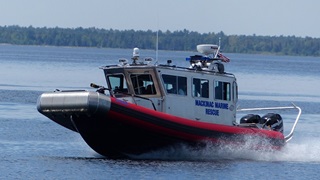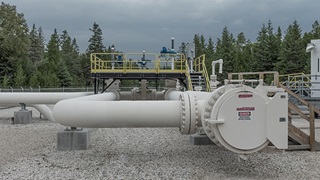What a well-built, well-maintained, 63-year-old pipeline looks like
Original segment of Line 5 a testament to extraordinary engineering, decades of vigilant maintenance
This is what a well-maintained, 63-year-old oil pipeline looks like.
Inspection results along Enbridge’s Line 5 have regularly indicated that from an engineering and maintenance perspective, the pipe, while not perfect, is like new and in excellent condition.
An original segment of Line 5, recently unearthed during a pump station upgrade near the Straits of Mackinac, confirms these results.
“It’s a common misperception that Line 5 was laid in the ground and forgotten. In reality, a lot of care and attention is devoted to protecting the pipe before it goes underground or underwater—and a lot more in the course of its operation,” says Blake Olson, operations manager for Line 5 in northern Michigan and the Straits of Mackinac.
The photo above shows a piece of Line 5 that was removed during our Mackinaw City pump station upgrade in July. The left portion of the pipe is covered by a fiber-reinforced enamel coating that provides an impermeable barrier against the elements. The center portion shows a formidable weld seam, and the right side shows the condition of the pipe under the enamel coating.
This segment of Line 5 operated underground, not underwater, and was buried at a depth of about five feet.
Safety is the very foundation of our business at Enbridge, and prevention is the primary focus of our pipeline safety strategy. In addition to our industry-leading pipe steel design and construction standards, our prevention techniques include:
- Regular in-line inspections, using high-tech, MRI-like tools that examine our pipes from the inside out;
- Cathodic protection, which involves the application of a low-level electrical current to prevent the pipe steel from reacting to environmental conditions;
- 24/7 monitoring, using specially trained staff and sophisticated computer modelling systems at our pipeline network control center;
- Verification and maintenance digs, when our in-line inspections identify pipeline features that may require further attention;
- Remotely controlled isolation valves, which can be fully closed within three minutes by our control center staff upon detection of a problem;
- Testing every batch of product in our pipes to meet strict quality standards for viscosity, density, temperate, and sediment-and-water content;
- Minimizing pressure cycling to reduce stress on pipeline steel; and
- Regularly cleaning the interior walls of our pipes with special tools.
Enbridge’s Line 5 Straits of Mackinac crossing includes further safety precautions to promote the line’s continued safe and reliable operation.
Pipelines, including Enbridge’s Line 5, have an indefinite lifespan if they are properly operated, monitored and maintained. In 2013, then-U.S. National Transportation Safety Board (NTSB) chairwoman Deborah Hersman testified before the Senate Commerce Committee: “If (a pipeline) is adequately maintained and inspected, age is not an issue.”
This particular 30-foot segment of Line 5 is being shipped to Germany, where it will help Enbridge’s inspection tool manufacturers calibrate their inspection devices, and more accurately distinguish between manufacturing and corrosion anomalies.
(TOP PHOTO: An original segment of Line 5, recently unearthed during a pump station upgrade near the Straits of Mackinac. The left portion of the pipe is covered by a fiber-reinforced enamel coating that provides an impermeable barrier against the elements. The center portion shows a formidable weld seam, and the right side shows the condition of the pipe under the enamel coating.)










